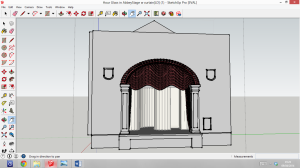
It is difficult to find out definitively the colour and texture of the screens, while light played a huge role in Craig’s ideas, there is little mention of the materials that make up the screens. It seems the screens were made of moveable wooden frames. I chose to go with a ‘silk’ material for the screens. I chose this because, despite lack of evidence, I surmised it would have been a light weight natural material. It could just have easily have been a light weight wood. The colour of the screens used in The Hour-Glass is referred to on a several occasions. A review of The Hour-Glass in 1911 mentioned “neutral tinted” screens and props of the same hue (Irish Times, 13 January 1911). Innes writes of the success of The Hour-Glass with “Craig’s ivory coloured screens”.
The stock textures in SketchUp were not suitable so I obtained the ivory texture from a Google image search. Initially I found it difficult to apply this texture the surfaces of the model in SketchUp, however once I updated to a trial version of SketchUp Pro the process was much more intuitive. The areas to be texturized had been saved as components. I selected the component I wanted to add texture to and, after uploading my own texture to the Paint Bucket tool, I pasted the texture on. As I had selected silk for the screens I chose to change the opacity to 75% allowing some light to penetrate the material.

Using a similar method I added a velvety texture to the stage colours. I chose a burgundy colour here but this is pure projection as I am unsure as to the actual colour. Finally, from looking at the surfaces in the model in the Old Abbey Theatre project I projected a grey plaster texture to the walls.

The next stage of the process was to add the props: a desk, chair, book and hour glass. I chose simple designs from the SketchUp Warehouse and resized them, placing the hour glass on a pedestal like I had seen in the print of the 1905 production of The Hour-Glass . I added the same texture to the props as to the screens as indicted in the above mentioned Irish Times article. I decided to centre the props in the niche of the sets. This decision was made in accordance with a sketch by Craig that is reproduced the Cave’s book and Dirst’s commentary “The desk, now in profile, is in an alcove at the right from corner, in shadow. From the study, a corridor of screens curves round to the left, disappearing back centre stage into light. This arrangement suggests that the Wise Man’s place is at one point of a circular pathway, that his domain of learning is at the dark end of a path moving towards light.”
Unfortunately once uploaded to SketchFab the textures of the above screen shots was lost, requiring more research into a more suitable platform.
Tutorial Videos Consulted:
Sketch-Up: Mapping photo textures to curved surfaces
Smart Texturing with Tgi SU Amorph Plugin for Sketch-Up
Sketch-up #27: Advanced Textures
SketchUp Tutorial Advanced Texturing
How to Import Texture to Google Sketchup
Further Reading:
Innes, Christoper, Edward Gordon Craig: A Vision of the Theatre, 2nd ed. Amsterdam: Harwood Academic Publishers
Cave, Richard. Ed. W.B. Yeats: Selected Plays. London: Penguin Group, 1997
Dirst, Shelly Sharpe, From The Hour-Glass to At The Hawk’s Well: Revisions Towards an Idealized Theatre,South Carolina Review; Spring 2004, Vol. 36 Issue 2, p120


